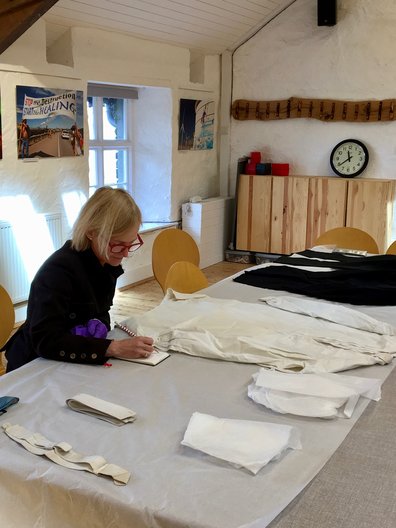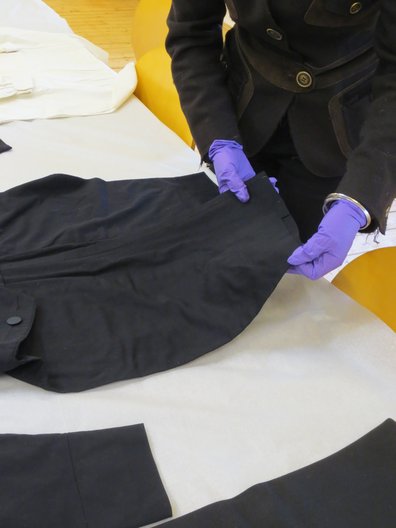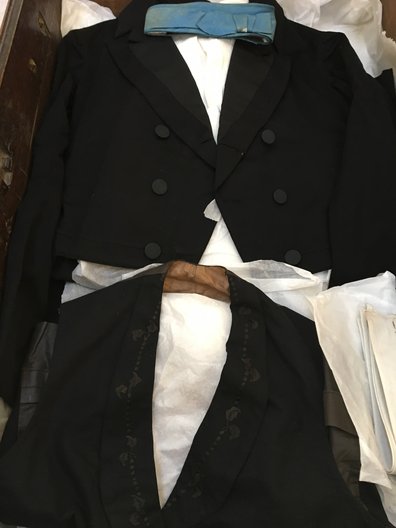8 May 2018
In this final blog post, Sarah Casey and Ingrid Mida, research partners on an AIDF funded project, report on a visit to Brantwood by The Dress Detective.
In April 2018 Sarah Casey and Ingrid Mida travelled to Brantwood in the Lake District, the former home of 19th century art critic and author John Ruskin. Sarah is creating work based on the extant garments of John Ruskin for an exhibition to mark the bicentenary of Ruskin’s birth in February 2019 called Ruskin’s Good Looking! Ingrid’s visit allowed her to examine the garments in person in order to support Sarah’s work and write a catalogue essay for the exhibition. She was also able to share her knowledge and expertise with Director of the Brantwood Trust, Howard Hull.
Ingrid: Can you talk about how you came to draw Ruskin’s garments?
Sarah: I was invited by Howard Hull to visit Brantwood to take a look at the Ruskin clothing they had in their collection. We developed the idea of a project from there, based around the fact the one of the garments is a christening robe, which had resonance with the fact that the bicentenary celebrations of Ruskin’s birth would be held in 2019.
Ingrid: How many times have you visited? How has the experience been different from your trips to other archives, like Ryerson University or the Bowes Museum?
Sarah: This experience has been quite unlike working with any other collection - Brantwood is a historic house, not a museum, which imparts a strong sense of the domestic. So far I have visited Brantwood five times. Some of these visits have been for consecutive days, staying overnight. Brantwood has accommodation attached to the workspace which means that I have been able to work through the night, sometimes drawing until 1am then getting up to draw again at 6am. It has been intense, but has enabled me to make particularly detailed drawings and draw some items multiple times.
Ingrid: How many garments are there? Which one do you find most interesting?
Sarah: The garments at Brantwood include the robe and cap from his Christening; as well as adult clothing comprising: a pair of trousers, shirt, waistcoat, jacket, 2 sets of his trademark blue stocks, a white collar, white stocks and a hat. I have now drawn it all using the mapping method I developed with you at Ryerson, apart from the shirt, which I plan to do in another visit. I am not sure what my favourite thing is. The blue stocks are very powerful as they are so evocative of Ruskin.
Ingrid: I particularly like the multiple views of Ruskin’s folded trousers. I see an unfolding of meaning in this work. Now only am I able to catch a glimpse inside and see the striped inner waistband, there is also a sense of mystery about what cannot be seen in the folded parts somewhat like the man himself. Were the trousers presented to you folded or did you lay them out this way?
Sarah: The Ruskin garments at Brantwood are stored folded up and were presented to me this way. In order to view them I had to handle them and unfold them. This unfolding held an uncanny intimacy that felt almost transgressive, like an invasion of privacy. I wanted to try to draw that. If you think about it, it is a very intimate thing to fold someone’s clothes, usually only undertaken within a close domestic environment. Again its about using drawing to try to communicate some of the embodied sensation of viewing and handling the artifacts.
Sarah: What can you understand from the garments – what kind of information is it possible to extract or deduct through close looking?
Ingrid: I see clothing as a material memory since the imprints of its intimate relationship to the body become embedded in the textile. As I study a garment, I look for the marks and stains of living and the rips, strains and tears of movement and sometimes as I do so, I feel the presence of the person that once wore that garment.
As I examined Ruskin’s clothing, I was looking for signs of use, wear and alteration. These stains of living are signs that he once inhabited the garments and also tell me something about the man himself. I am also looking for stylistic clues and other evidence that tell a fuller picture about the biography of the man. My observations from examining these garments will become part of the catalogue essay that I am writing for your exhibition.
Sarah: What did you find most fascinating about the visit to Brantwood and the opportunity to examine this clothing?
Ingrid: Ruskin’s affinity for drawing looms large in my mind and I have often quoted Ruskin in talking to my students about the value of drawing - not to make an accurate representation of a garment or an artwork but in order to better see the object before them. In 1857, Ruskin wrote in a passage from The Elements of Drawing that I echo. He said: ‘sight is a more important thing than the drawing; and I would rather teach drawing that my pupils may learn to love Nature, than teach the looking at Nature that they may learn to draw’. The opportunity to be able to study Ruskin’s garments up close at Brantwood and interpret them to add to the documentary record about this important figure from history has been an honour as well as a memorable career highlight.





